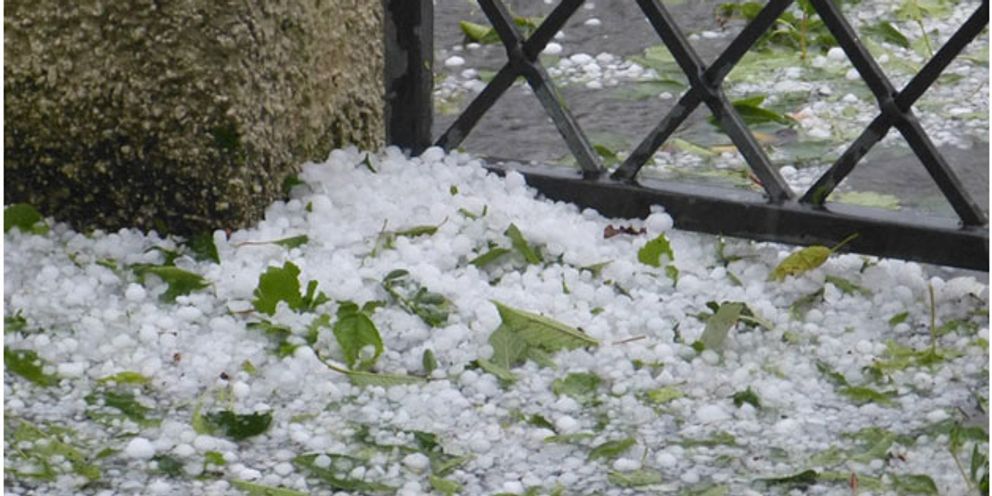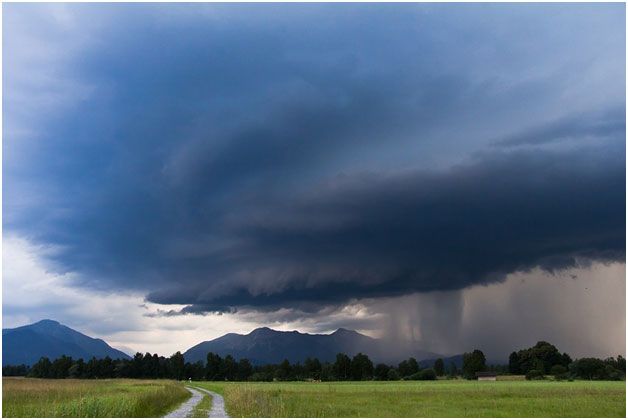
The 22 Worst Hailstorms in US History
Written By: John Linden
A hailstorm can be a memorable experience. You may recall being thrilled by ice falling during a thunderstorm while indoors, warm and protected as a child. Or maybe your first encounter, like mine, was finding an underpass to shelter your car during an unexpected hailstorm on the way to a job interview. If you’ve experienced this phenomenon even once, it is sure to have left an impression. Most hailstorms are mild, causing little damage and no serious injury, but occasionally these weather events can cause billions in property damage and even loss of life. In this article, I will share the 22 worst hailstorms in US history. But, before that, some information:
What is a Hailstorm?
A hailstorm is a thunderstorm that produces round balls or lumpy clumps of ice which fall to Earth and are referred to as “hail” or “hailstones”. Hail is sometimes confused with sleet, but sleet consists of small, clear pellets of frozen rain and is not produced by thunderstorms. Hail is made when there is a strong, upwards wind (called an “updraft”) and cold atmospheric temperatures during what could otherwise be thought of as a typical thunderstorm. Because of the low temperatures, ice particles form within the clouds, but they do not fall from the sky immediately because of the updraft. During this time, they grow in size by attracting additional moisture from the storm clouds or combining with other hailstones. When they get too heavy to be supported by the wind any longer, they fall from the sky. So, the stronger the updraft, the bigger the hailstones. A small hailstone (less than half an inch) can fall at a rate of about 20 mph while the largest reach a velocity of over 100 mph.

Image Credit:SturmjaegerTobi / Pixabay
Where are Hailstorms common?
Any thunderstorm has the potential to cause hail. Hailstorms are most common in areas near mountain ranges because mountains force air to flow upwards, creating an updraft. Hailstorms are also very common in areas where the atmospheric temperature is low. For these reasons, most hailstorms in the US occur in an area known as “Hail Alley”, near the Rocky Mountain Range, where Colorado, Nebraska, and Wyoming connect. Hailstorms are common in land-locked, plains states from Texas to the Dakotas and over to western Missouri including Kansas and Oklahoma. While warmer states (Florida, for example) are prone to thunderstorms and see their fair share of hail, warm air temperatures usually prevent larger, more damaging hailstones from developing so none of these storms made the list.
How do Hailstorms cause damage?
Since a baseball-sized hailstone can fall as fast as a major-league pitch, it is easy to imagine how sudden hailstorms can cause injury to people. However, casualties due to hail are uncommon in the U.S. due to improved infrastructure and early warning systems. The most common hail damage loss to American communities is agriculture: crops and livestock. Hailstones can also cause damage to vehicles and buildings. Windshields, glass roofs and skylights are particularly at risk. A 2004 hailstorm in Canada caused 20,000 people to be evacuated from a mall when the glass atrium roof shattered and caved in. Only 4 people are known to have died in hailstorms in America since 2000. However, hailstorms have claimed many lives abroad in the past. Notably, during the Hundred Years War in 14th century Europe, 10,000 English soldiers were killed during an intense hailstorm. The soldiers, living in tents, had no protection from being pelted with ice. India and China have significant problems with hailstorms in mountainous, rural areas causing casualties to this day.
The 22 Worst Hailstorms in US History:
#22: “Early Records”
July 6,1928. Potter, Nebraska.
The earliest record of record-worthy hailstones “hails” from the Cornhusker State. In the summer of 1928, a 7-inch, pound-and-a-half hailstone fell and was believed to be the largest ever in the States at the time.
#21: “Largest Hail in SoCal”
September, 2 1960. Southern California.
This storm dropped golf ball to baseball sized (2.75”) hail in parts of Riverside County and is still the largest hail recorded in Southern California.
#20: “Oil Tank Explosion”
December 1967. Los Angeles County, California.
Reportedly, in the winter of ‘67 a hailstorm left an area of Los Angeles County blanketed in ice. The storm is reported to also have produced a lightning strike which hit an oil tanker, causing an explosion and oil spill.
#19 “A New Record”
September 3, 1970. Coffeyville, Kansas.
This storm in the Sunflower State produced the largest hailstone on record at the time, topping the 1928 size record at 5.7” diameter and one-and-two-thirds pounds (1.67 lbs).
#18 “A Child is Lost”
July 30, 1979. Fort Collins, Colorado.
A tragic, 40-minute storm claimed the life of a 3-month-old baby as her mother ran for cover. 25 additional people were reported injured by falling hailstones.
#17 “Damage in Denver”
July 11, 1990. Denver, Colorado.
Four storms on this list occurred in Colorado. This one caused $625 million in total damage, dropping softball-sized hail that damaged homes and vehicles.
#16 “Double Trouble”
June 19, 1992. Wichita, Kansas.
$500 million in property damage and $100 million in crop damage were the aftermath of this pair of severe thunderstorms which passed through south-central Kansas, back-to-back within 6 hours of each other.
#15 “The Mayfest Storm”
May 5, 1995. Dallas and Fort Worth, Texas.
Residents celebrating at a local, outdoor festival known as the “Fort Worth Mayfest” had their festivities interrupted by 4” and larger hailstones during a supercell thunderstorm that caused a total of around $2 billion in damage.
#14 “Tragic Hail Fatality”
March 29, 2000. Lake Worth, Texas.
One of the last recorded hail fatalities in the US occurred in Lake Worth, TX in 2000 when a 19-year-old young man was struck in the head by a softball-sized hailstone.
#13 “Three Inches Deep”
May 18, 2000. Chicago area, Illinois.
A widespread Chicago area hailstorm caused almost $600 million in damages as well as cutting power to over 100,000 homes. Hail accumulated to over 3 inches deep in certain areas, causing many transportation issues.
#12 “Costliest in US History”
April 10, 2001. St. Louis, Missouri.
An unusually persistent hailstorm struck the I-70 corridor across part of Kansas, Missouri and into Illinois. Baseball-sized hail was reported in all three states.
#11 “Another New Record”
June 22, 2003. Aurora, Nebraska.
A gentleman in Nebraska “risked life and limb” to retrieve the hailstone that still holds the record for the largest circumference officially measured. It has a diameter of 7” and a circumference of 18.74” and has been described as “bowling-ball sized”.
#10 “Dealership Damages”
April 20, 2006. San Marcos, Texas.
4-inch hail caused 10,000 auto insurance claims outside of causing catastrophe at a stricken Toyota dealership. One woman was hospitalized as a result of this Texas storm.
#9 “Suburban Storm”
July 20, 2009. Denver, Colorado.
At the time, this storm was the costliest in state history. Widespread hail damage and two confirmed tornadoes caused over $700 million in damage to suburban Denver communities.
#8 “Twice in One Week”
May 10 and May 16, 2010. Oklahoma City, Oklahoma.
In an unlucky week in Oklahoma, two major hailstorms occurred its 6 days apart: The first on a Monday and the next on the following Sunday. The twin storms totaled approximately $1 billion in damage.
#7 “The Current Record Hailstone”
July 23, 2010. Vivian, South Dakota.
The hailstone that currently holds the official record for diameter fell during this storm and measured almost 8” across and weighed almost 2 lbs.
#6 “Phoenix Gets Pummelled”
October 5, 2010. Phoenix, Arizona.
Arizona is a state unaccustomed to hailstorms so this storm in October of 2010 was a real surprise. Golf ball sized hail did serious damage to homes and automobiles totaling $2.7 billion dollars.
#5 “Second Costliest in US History”
April 28, 2012. St. Louis, Missouri.
Two supercell thunderstorms dropped baseball sized hail on large swaths of St. Louis damaging businesses, homes, and other property to an estimated $1.6 billion dollars in losses.
#4 “Destruction in Dallas”
June 13, 2012. Dallas and Fort Worth, Texas.
The fourth costliest hailstorm in Dallas History caused $900 million in damages across the Dallas / Fort Worth area.
#3 “Costliest Texas Hailstorm”
April 16, 2016. San Antonio, Texas.
Still the costliest storm in Texas history, this weather system dropped up to grapefruit-sized, 4” hailstones and caused over 1.4 billion dollars in damage.
#2 “Most Catastrophic in State History”
May 8, 2017. Denver, Colorado.
What is known as “The Front Range Hail Storm” struck at rush hour, trapping commuters in cars and busses while they were pelted with baseball sized hailstones. This storm caused over $2 billion in damage, costing more than the years wildfires and securing the record for deadliest Colorado storm to this day.
#1 “Multi-State Superstorm”
9 June 2017, Minneapolis, Minnesota.
A line of thunderstorms developed in North Dakota in the early morning hours and headed Eastward to wind up in Michigan by the early afternoon. Along the path of destruction, the Minneapolis metro area suffered the most with damages estimated to be over $2.5 billion.
In 2017, hailstorms caused over $22 billion in damages in the United States. With many news outlets predicting that may top that figure, becoming the worst year in history for hailstorm damage, hailstorms are becoming more of a concern for more Americans than ever. If you would like to learn more about what you can do, check out our article “How to Prepare for a Hailstorm”. Do you remember any of these storms? What is the worst hail you’ve ever experienced? Share your thoughts in the comments.
REFERENCES
https://www.wunderground.com/cat6/record-hailstorms-and-hailstones-us
https://en.m.wikipedia.org/wiki/List_of_costly_or_deadly_hailstorms
https://en.m.wikipedia.org/wiki/Hail
https://weather.com/storms/severe/news/hail-climatology-united-states
https://www.cbsnews.com/news/hail-damage-costs-this-year-could-hit-new-annual-high-in-u-s
Updated